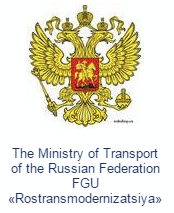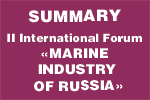International forum
“Marine Industry of Russia”
Moscow, “Gostiny Dvor”
Exhibition Hall,
May 16-18, 2012
Time left till opening of the Forum:
340 days 0 hours 11 minutes
Electronic catalogue
Search for the participant >>>
Enter the site >>>
Forum bulletin
NEWS of marine Forum
February 17, 2011
The crew of tanker “NS Century” owned by Novoship is reported by the Press Service of the shipping company to have defeated the armed attack in Indian Ocean.Sovcomflot tanker defeats armed attack in Indian Ocean
December 14, 2010
New Year special offer! Gift registration fee for participation in Forum till January 15!
October 12, 2010
“It is feasible to develop high-technology relying on domestic resources!”Interview with Lev S. Lazarev, Director General of “Muromsky Radiozavod
Russian Sea and River Ports – Overview
Russian sea and river ports are main centers of transportation and distribution of the international and domestic commerce benefitting development of the economy of the country. Currently in Russia, there are over 50 large ports at 9 seas and the Pacific Ocean.
Depending on their geographical position, sea ports are included into one of the following 4 groups: Baltic, Northern, Southern and Far-Eastern basin.
The most important ports of the Northern basin are:
- Arkhangelsk,
- Kandalaksha,
- Murmansk.
In the Baltic basin:
- Vyborg,
- Vysotsk,
- Kaliningrad,
- Saint-Petersburg.
In the Southern basin:
- Novorossiysk,
- Taman,
- Kavkaz.
In the Far-Eastern basin:
- Vostochny,
- Vanino,
- Kozmino,
- Prigorodnoye (Sakhalin island),
- Petropavlovsk-Kamchatsky.
Current Situation
Sea ports are key elements of the Russian transport complex assuring relationships of various kinds of transportation (automobile, railway, etc.). Over 60% of foreign-trade freight traffic of the country accounts for them.
Most of Russian ports were built in 60-70’s of the past century. Their state does not meet modern requirements for water depth at berths and in water areas. About half of the ports (31) are shallow, so they cannot serve vessels with deadweight over 10 thousand tons. There are only 10 ports in Russia capable of serving modern vessels with deadweight over 50 thousand tons. Vessels with deadweight over 150 thousand tons can be served only in one sea port – Murmansk.
Today, there are over 1500 items of immovable property (including 521 berths with total length of 80 km) on the balance sheet of Rosmorport FGUP PO.
Most Russian ports are located in freezing seas, which makes necessary the ice channeling 2-6 months. Kaliningrad, Murmansk and ports of the Southern basin are exceptions.
The Federal Law On Sea Ports of the Russian Federation and On amendments to the Federal Law On Special Economic Zones in the Russian Federation regulate the activity of the ports.
According to the Ministry of Transportation of the Russian Federation, it is necessary to fill gaps of the current legislation by defining the limits of the state interference into economic and property relations, limit overlapping of business activities and state functions within a single party, raise effectiveness of implementation of the powers, and eliminate reflection of authorities of various federal bodies.
Prospects and Trends
According to the Association of Commercial Seaports (ASOP) having the main task of coordinating efforts on creating conditions of effective development of sea transport enterprises, the freight turnover of the Russian ports for the last 10 months of 2009 was 412 mln. tons, an 8.2% growth compared with the same period of the last year. The tendency of freight turnover growth is observed in volumes of transshipment of dry and bulked cargoes. Transshipped exported cargoes (coal, ferrous and nonferrous metals, corn, ore) increased by 10.9%. The freight turnover of mineral fertilizers, timber cargoes and containers decreased.
Rosmorport FGUP expects the volume of container transshipment in the ports of the Baltic basin to grow up to 2.6 mln. TEU (this unit of volume of cargo is based on dimensions of the standard 20-meter length container) by 2012. Today, total container transshipment volume in Russian seaports of the Baltic basin is 3.5 mln. TEU per year. Even with increasing of transshipment volume, there is a significant excess of container terminal facilities in the Baltic basin. Besides, the part of containers for Russia is served in Finland and the Baltic states. However, Russia needs in expanding port facilities.
Since growth rates of import and export volumes are accelerating, Russian and foreign investors pay more attention to the port industry. With the aim of enhancing investment attractiveness, Russian authorities accepted a number of strategic programs, including Set of Measures on Development of Ports and Special Economic Port Zones program and Program for the Retrofitting of the Transport Infrastructure of the Russian Federation (2002-2010).
It is expected that in 2010 Russian seaports will serve at least 520 mln. tons of dry and bulk cargoes.
© Marine Industry of Russia, 2009-2010. All rights reserved.
By: “Ideological buiseness-projects”
Design by Valentina Ivanova.









